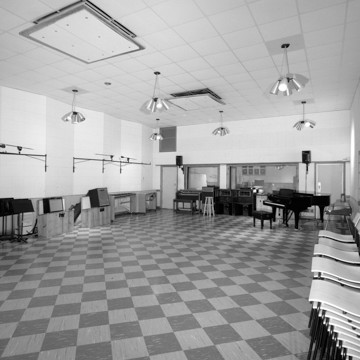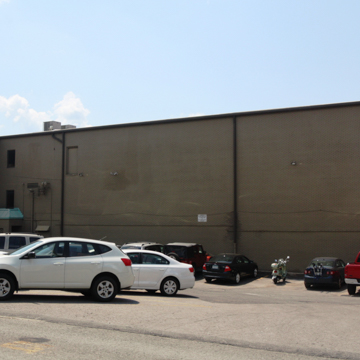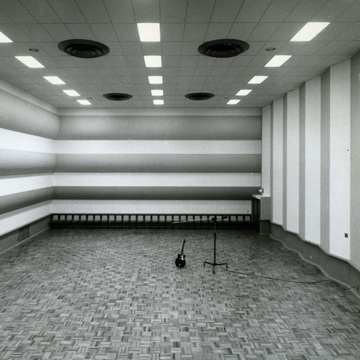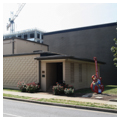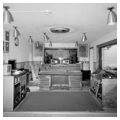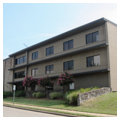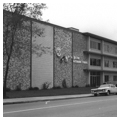You are here
RCA Victor Studios
Located on Nashville’s legendary Music Row, RCA Victor Studios is a commercial music recording studio complex consisting of two adjoining buildings constructed between 1957 and 1965. Known individually as RCA Studio A and RCA Studio B, the mid-century modernist complex contains two of the most significant purpose-built music recording studio buildings in the world. Taken together, the studios reflect the rise and evolution of Nashville’s country music industry from the 1950s to the 1980s. The complex is exceptionally significant for its association with the many artists, musicians, singers, songwriters, engineers, and producers who revolutionized music from within these studio spaces. Facing Roy Acuff Place, RCA Studio B is a one- and two-story masonry building constructed in 1957. In 1964–1965, the complex was enlarged with the three-story RCA Studio A building facing Music Square West.
The RCA Victor Studios complex contains facilities for sound recording and mixing, with spaces specially designed for optimum acoustic properties. The adjoining buildings feature studios, or “live rooms,” where instrumentalists and vocalists perform; control rooms where sound engineers and producers operate professional audio mixing consoles and digital computers with specialized software; smaller isolation booths and demo studios; specially-built echo chambers; songwriting spaces; offices; and support spaces for amplifiers, tracking equipment, lounges, kitchens, bathrooms, and equipment storage. From the street, these nondescript studios, linked by a covered walkway, resemble industrial warehouses. Within, though, these are sophisticated recording studios, featuring state-of-the art sound-mixing equipment and control rooms, specially designed studio walls and ceilings, echo chambers, and smaller demo studios.
Studio B was erected in 1957 by local entrepreneur Dan Maddox for $37,515 and leased to RCA Records, which used RCA sound engineers from Nashville and New York to set up the sound equipment, producing a room of exceptional sound quality. Designed by RCA recording manager Bill Miltenburg, this simple, flat-roof, concrete-block modern building has very few windows and doors. The severe facade is relieved with some decorative concrete blocks and entrance screening walls. The studio quickly outgrew its limited space and in 1961, it was enlarged with a simple concrete block rear addition.
The adjacent three-story Studio A was constructed in 1964–1965 for around $300,000, with a recording studio capable of accommodating an orchestra, as well as offices for publishing houses and music executives. The Studio A building was designed and built by William Briggs “W.B.” Cambron (1922–1992), a local architect and commercial contractor. The rectangular building was constructed of concrete block, but with brick veneer and bands of local sandstone trim on the facade. Studio A features a flat roof, horizontal ribbons of glass windows and cantilevered concrete ledges along the facade.
The RCA Victor Studios played a central role in the creation of the “Nashville Sound,” a pop-influenced approach to country music that developed in the 1960s. The complex is home to over a thousand hits and is one of the most important recording locations for Elvis Presley, who recorded over 250 songs here. Other artists who have recorded here include Chet Atkins, Tony Bennett, Perry Como, Ben Folds, Vince Gill, Faith Hill, Waylon Jennings, Jewel, B.B. King, Allison Krauss, Kathy Mattea, Willie Nelson, Roy Orbison, Dolly Parton, Lionel Richie, Nancy Sinatra, Carrie Underwood, and Keith Urban.
Nashville’s RCA Victor Studios represent pivotal changes in the architecture, technology, commerce, tastes, genres, and production styles of the American music industry. Studio A continues to operate as a commercial music recording studio with offices for music publishers, music associations, and music industry executives. It is currently owned by local businessmen and operated by record producer Dave Cobb. Since closing in 1977, Studio B has been operated by the Country Music Hall of Fame and Museum as an educational and museum facility open for paid tours; occasionally, it is also used for music recording.
References
Jones, Robbie D., and Carolyn Brackett, “Historic Music Industry Resources,” Davidson County, Tennessee. National Register of Historic Places Multiple Property Documentation Form, 2016. National Park Service, U.S. Department of the Interior, Washington, D.C.
Hopkin, Rachel, “RCA Studio B, Nashville,” Davidson County, Tennessee. Historic American Building Survey Documentation Form, 2012. National Park Service, U.S. Department of the Interior, Washington, D.C.
Kosser, Michael. How Nashville Became Music City, USA: 50 Years of Music Row. Milwaukee: Hal Leonard Corporation, 2006.
McNutt, Randy. Too Hot to Handle: An Illustrated Encyclopedia of American Recording Studios of the Twentieth Century. Hamilton, OH: Hamilton Hobby Press, 2001.
Robison, Julie, Tara Mielnik, and John Rumble, “RCA Studio B,” Davidson County, Tennessee. National Register of Historic Places Inventory–Nomination Form, 2012. National Park Service, U.S. Department of the Interior, Washington, D.C.
West, Carroll Van, “RCA Victor Studios Building,” Davidson County, Tennessee. National Register of Historic Places Inventory–Nomination Form, 2015. National Park Service, U.S. Department of the Interior, Washington, D.C.
West, Carroll Van. Nashville Architecture: A Guide to the City. Knoxville: University of Tennessee Press, 2015.
Writing Credits
If SAH Archipedia has been useful to you, please consider supporting it.
SAH Archipedia tells the story of the United States through its buildings, landscapes, and cities. This freely available resource empowers the public with authoritative knowledge that deepens their understanding and appreciation of the built environment. But the Society of Architectural Historians, which created SAH Archipedia with University of Virginia Press, needs your support to maintain the high-caliber research, writing, photography, cartography, editing, design, and programming that make SAH Archipedia a trusted online resource available to all who value the history of place, heritage tourism, and learning.




